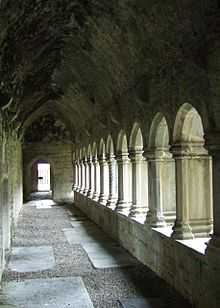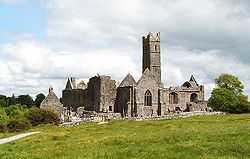Quin Abbey
|
Quin Abbey | |
 Location within Ireland | |
| Monastery information | |
|---|---|
| Other names | Quin Friary |
| Order | Franciscans |
| Established |
c. 1350 (church), 1433 (abbey) |
| Disestablished | 1541 |
| People | |
| Founder(s) | MacNamara family |
| Architecture | |
| Heritage designation | National Monument |
| Style | Gothic |
| Groundbreaking | 1402 |
| Completed date | 1433 |
| Site | |
| Location | Quin, County Clare, Ireland |
| Public access | yes |
Quin Abbey, is a ruined Franciscan abbey or friary in Quin, roughly 9 miles from Ennis, County Clare in Ireland. It was built in the Gothic style in the early 15th century on the remains of an earlier Norman castle. The abbey had a turbulent history, with the friars driven off or killed numerous times. Officially suppressed in 1541, the abbey continued to be inhabited by a small number of friars until 1820. Today, Quin Abbey is a National Monument.
History
The church that later became Quin Abbey was founded by the MacNamara family around 1350. From the 14th century the MacNamara clan was the most powerful family in the Baronies of Upper and Lower Bunratty and Upper and Lower Tulla. Making use of the remains of an earlier Norman castle (see below), notably the south curtain-wall, they constructed a church. North of the church, a residence for the clergy and a small sacristy were added. Sioda Cam MacNamara built the cloisters in 1402. In 1430, the bell-tower and Lady Chapel were built by Mahon MacNamara. In 1433, he gave the property to the Franciscan order and allowed them to establish their friary there.[1] Reportedly, the first friars were Fathers Purcell and Mooney.[2]
In 1541, during the Reformation, King Henry VIII suppressed and confiscated the abbey and it passed into the hands of the O'Brian (or O'Brien) family, eventually to Conor O'Brian, Earl of Thomond.[1][3] The O'Brians allowed the friars to continue living there. By 1548, the abbey had fallen into disrepair, and was described as "one great church, now ruinous, covered with slate, and a steeple greatly decayed".[1]
In 1584, Sir John Perrot, Lord Deputy of Ireland, had one Donough Beg O'Brian half-hanged from a cart, his bones broken with the back of an axe, and hung, still alive, on the steeple of Quin Abbey. The abbey served as a barracks for English forces until another Donough O'Brian burned it down.[1] In about 1590, the MacNamaras regained control of the abbey and once again set about repairing and restoring it, helped by some other local families.[1][3] The high quality of construction had ensured that the walls suffered little damage. By 1604, the choir and Lady Chapel had been roofed over and the ground-floor living areas made habitable again. In 1617, the Irish Franciscan Provincial, Father Donough Mooney, took note of the repairs and described the two or three friars then in possession as being "old, helpless men with scarcely a memory of the pre-suppression friary". An altar plate of gold and silver had been given to one of the MacNamaras of Knappogue for safekeeping, but had died before he could divulge the location of the hiding place.[1] In about 1640, the building became a college and is alleged to have had 800 students.[3]
In 1651, Cromwellian forces killed the monks and destroyed the abbey. Fr. Rory MacNamara was shot and beheaded, Fr. Donald Mac Clancy and Br. Dermot MacInerney were hanged. By 1667, the Franciscans had returned and Fr. Moriarty O'Griffin was named as guardian in 1670.[1] In 1671, the abbey was once again restored, but never regained its former status.[3] By 1681, the abbey was reported empty once again. Yet by 1691 the friars had returned when the cavalry of the defeated Irish army was encamped around the walls of the abbey after the Battle of Aughrim.[1]
The friars were expelled again by Colonels William and Henry Stamer (of Carnelly, High Sheriffs of Clare) at some point before 1760, but remained in the nearby townland of Drim. One friar continued to live in the abbey ruins and others succeeded him. The last Friar, Father John Hogan of Drim, remained at the abbey until his death in 1820, by which time the buildings were ruined by neglect. Around 1880, the Board of Public Works took over and the abbey was made a National Monument.[1][3]
Earlier structures
A far earlier monastic or ecclesial building had existed on the site, which burned down in 1278. A Norman castle was built soon after by Thomas de Clare[4] in order to subdue the MacNamara clan. It was a massive fortification with large rounded towers at each corner, the foundations of which can still be seen today. In 1286, the castle was burned down in an attack by Cuvea MacNamara, avenging the death of a chieftain of the O'Liddy (or Liddy) clan, killed earlier by the Norman garrison. Most of the defenders were killed.[1]
Parts of the castle towers still remain at the south-east, south-west and north-east corners of the abbey. Part of the vanished north-west tower, or at least its site, is also still visible. Most of what remained of the castle walls was incorporated into the abbey's south and east walls.[1]
Abbey structures

- The Lady Chapel is the resting place of the MacNamara chieftains, including the last, John "Fireball" MacNamara who died in 1836. Tombs date back to at least 1450.[1]
- Church tower with spiral staircase[1]
- Cloisters[1]
- Tower to the north of the main complex with a lavabo, or medieval toilet[1]
- Dormitory[1]
Today
Although mostly roofless, the structure of the abbey is relatively well preserved. The cloister and many other surviving architectural features make the abbey of significant historical value.[2]
A visitor centre is located near the abbey and the structure and grounds can be visited free of charge. A caretaker is permanently based at the abbey. Floodlighting has been installed which illuminates the site at night. The graveyard surrounding the abbey is still in use.
See also
- List of abbeys and priories in Ireland (County Clare)
- List of National Monuments in County Clare
References
- ↑ 1.0 1.1 1.2 1.3 1.4 1.5 1.6 1.7 1.8 1.9 1.10 1.11 1.12 1.13 1.14 1.15 "Quin, Places of Interest". Clare Library. Retrieved 16 August 2013.
- ↑ 2.0 2.1 Commissioners of Public Works (1906). 75th Annual Report of the Commissioners of Public Works in Ireland; Clonmacnois, King's County. A. Thom & Co, Dublin.
- ↑ 3.0 3.1 3.2 3.3 3.4 Meehan, C.P. (1877). The Rise & Fall of the Irish Franciscan Monasteries. James Duffy & Sons, Dublin.
- ↑ Brian Hodkinson, Was Quin Castle Completed?, North Munster Antiquarian Journal, Vol. 44, 2004, pp.53-8
External links
| Wikimedia Commons has media related to Quin Abbey. |
| ||||||||||||||||||||||
Coordinates: 52°49′9.43″N 8°51′46.87″W / 52.8192861°N 8.8630194°W
